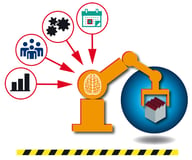5 Important Logistics 4.0 Stats to Know
Brian Hoey - February 26, 2019

 So far, the story of Logistics 4.0 is largely one of untapped potential. As a critical counterpoint to Industry 4.0, Logistics 4.0 represents the promise of a highly responsive supply chain that can self-monitor and self-adapt, but so far this promise has only been met in a few select areas. Though smart pallets, smart containers, and smart ports are quickly becoming a reality in global shipping routes, most businesses aren’t in a position to take advantage of those things in a value additive way. That said, slow change is better than no change, and the face of logistics really is evolving. As we more firmly enter the Industry 4.0 era in manufacturing, shipping and freight forwarding paradigms will have to keep up by offering the same levels of integration and digitization as their industrial counterparts.
So far, the story of Logistics 4.0 is largely one of untapped potential. As a critical counterpoint to Industry 4.0, Logistics 4.0 represents the promise of a highly responsive supply chain that can self-monitor and self-adapt, but so far this promise has only been met in a few select areas. Though smart pallets, smart containers, and smart ports are quickly becoming a reality in global shipping routes, most businesses aren’t in a position to take advantage of those things in a value additive way. That said, slow change is better than no change, and the face of logistics really is evolving. As we more firmly enter the Industry 4.0 era in manufacturing, shipping and freight forwarding paradigms will have to keep up by offering the same levels of integration and digitization as their industrial counterparts.
Let’s look at some statistics in order to dig deeper into the present-day realities of the shipping and freight forwarding industries.
1) 50% of Logistics Providers
List “lack of digital culture and training” as the top hurdle to adopting effective digital logistics workflows. Given what we said in the paragraph above, this shouldn’t really come as much of a shock. In order for businesses to fully take advantage of the cyber-physical systems that define Industry 4.0 and Logistics 4.0 workflows, they first need to invest in IoT (internet of things) devices and RFID chips that can gather data from things like trucks and containers, and that data has to stored in a way that makes it accessible not just to planning workflows, but to analytics processes that can help drive improved forecasts and prescriptive process improvements. To reach this level of data integration, shippers and freight forwarders need to commit themselves to an open, highly visible IT infrastructure that privileges these kinds of processes. Not the kind of thing that happens overnight in even the most agile company.
Source: https://www.pwc.com/sg/en/publications/assets/future-of-the-logistics-industry.pdf
2) 15x the Investment
Has been poured into digital logistics providers by venture capitalists, compared to traditional logistics providers, since 2011. While the previous stat might have given some of you pause about Logistics 4.0’s prospects, this one should be a little more uplifting. Though these digital shipping processes are sometimes hard to implement, there still exists a real optimism about them. Why? Because they have the potential to add value in a whole host of ways. By implementing real time tracking of shipments, for instance, you can adapt your shipping routes in real time as better options become available (due to changing traffic and weather conditions or fluctuations in cargo pricing). In the same way, you can gain sufficient visibility into your resources and their availability that, when (not if) a disruption occurs, you can instantly visualize the best and most efficient methods for preserving value and maintaining on-time delivery. No wonder investors are excited about these new paradigms!
Source: https://www.pwc.com/sg/en/publications/assets/future-of-the-logistics-industry.pdf
3) 30% of Perishable Produce
The amount that never reaches its destination, as a result of inefficient or otherwise problematic logistics practices. This is a tale that’s much too common in modern logistics; because of breaks in the cold chain, perfectly good food fails to meet its destination. This is, of course, unfortunate from the perspective of meeting the world’s nutritional needs, but it’s also indicative of one of the many ways that Logistics 4.0 can add value for the logistics chain going forward. If shippers trying to move food across the country, for instance, could gain a more holistic account of the entire value chain, they could identify likely problem areas—to say nothing of responding to disruptions more quickly. In this way, they can ensure that a much greater percent of the product reaches its final destination in tact. Right now, we mostly think of these losses of perishable product as a fact of life, but in a fully digitized environment they doesn’t have to be.
4) 80% of the Time
How often forklifts in a given logistics chain will sit idle. This stat and the one above really go hand in hand. Why? Because they both point to the necessity—and also the latent competitive advantages—of Logistics 4.0 processes. Think of the improvements you could make to your bottom line by increasing the uptime of each element of your logistics chain. By using digital planning flows to optimize the use of trucks, pallets, containers, hubs, cross docks, etc., you can create an environment in which every touch point on the value works in synergy with the next. This means things like virtually-empty milk runs (which are shockingly common within the industry) can be largely eliminated through the use of more adaptable scheduling processes—for instance, you might track your clients’ production processes in real time through sophisticated supply chain integration, so that you can determine mathematically what the optimal time is to send a given shipment on its way, weighing the relative costs of waiting for a fuller truckload versus completing the run more quickly.
Source: https://blog.bosch-si.com/industry40/what-pragmatic-real-time-logistics-is-all-about/
5) 2 out of 3 Manufacturers
Struggle to share information between departments. We saw above the ways in which businesses in the logistics sector are struggling to digitize as quickly as they would like. Based on this stat, it should be pretty clear that the same issues currently plague the world of manufacturing. What implications does this have for Logistics 4.0? Well, since digital logistics workflows are dependent on value chain digitization and successful supply chain integration, it’s safe to assume that a non-Industry 4.0-enabled factory won’t be able power Logistics 4.0 processes, meaning that any digital logistics providers who partner with them will be hampering their own agility and flexibility by doing so. Since these two new paradigms are so interrelated, their rises are going to be simultaneous with one another. This means that the more successful manufacturers are at working towards Industry 4.0, the more logistics managers will be able to work towards Logistics 4.0 and vice versa. If you’re a shipper or a freight forwarder, you can help this process along by choosing to partner primarily with digital manufacturers.
Source: https://www.zetes.com/en/news/infographic-industry-40-key-hurdles-and-how-to-overcome-them
LATEST POSTS
- Understand Circular Economy in The Manufacturing Industry
- How Can Industry 4.0 IT Integration Be Achieved Smoothly?
- The Significance of Order Sequencing in Discrete Manufacturing
- How to improve your Supply Chain Management: The Power of Control Towers
- Optimizing Human Resource Scheduling in Manufacturing: A Technological Approach



